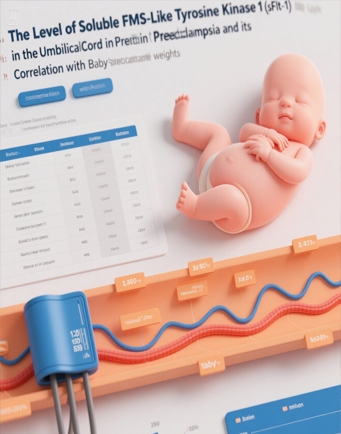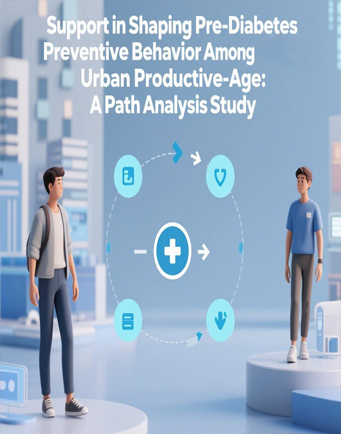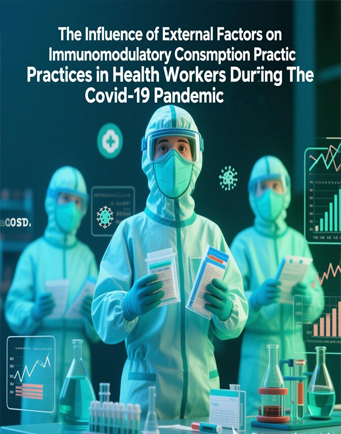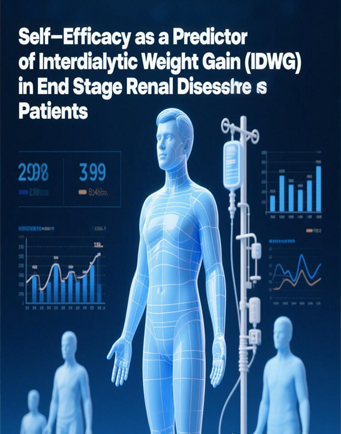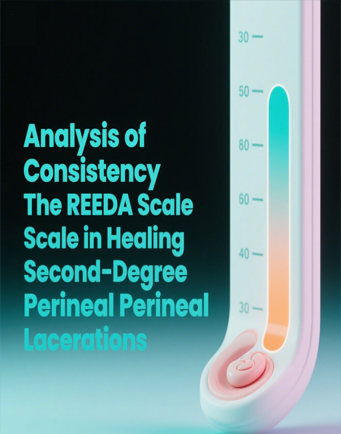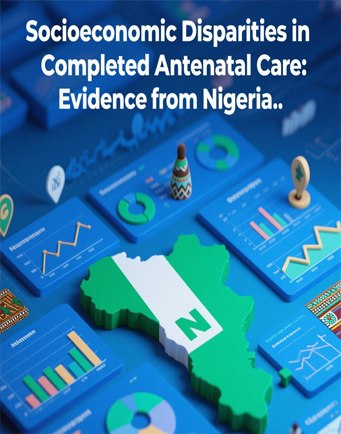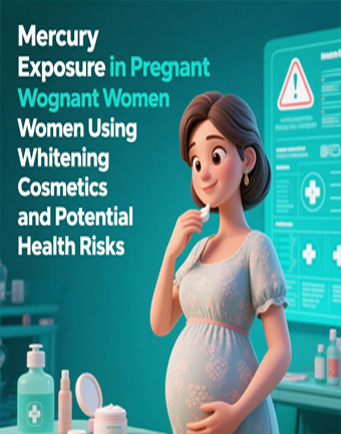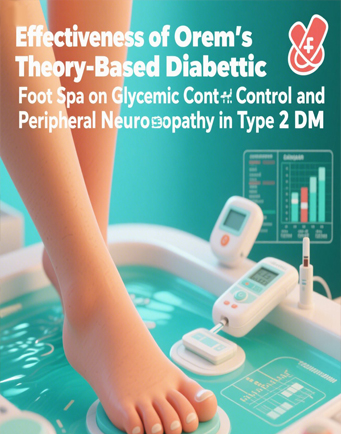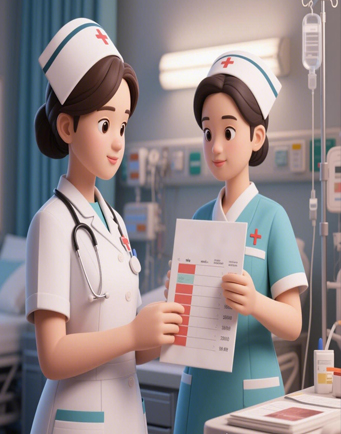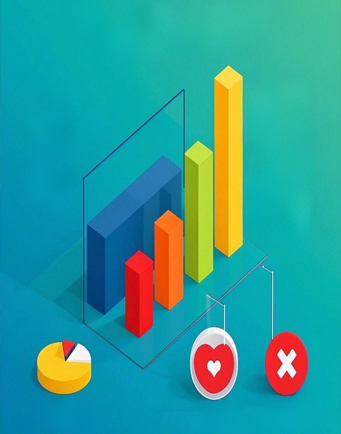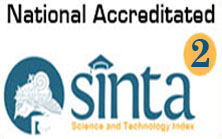Dietary Intake and Pregnancy Characteristics on Maternal Anemia Status
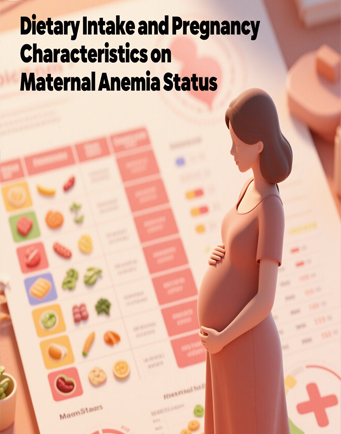
Downloads
Anemia during pregnancy remains a significant global health concern, affecting a substantial portion of the worldwide population. The prevalence of anemia is particularly high among pregnant women, especially in developing countries like Indonesia. Anemia during pregnancy can lead to severe complications for both mother and fetus, including increased mortality risk, premature birth, low birth weight, and cognitive impairment. Purpose: This study aimed to identify factors contributing to anemia, specifically examining food intake and pregnancy characteristics. A cross-sectional study was conducted from June to September 2023 at Parung Panjang Health Center, Bogor Regency, involving 135 pregnant women. Data collection included hemoglobin measurements using an easy touch device and nutritional intake assessment through SQ-FFQ interviews. Analysis was performed using SPSS version 23 with chi-square testing. The study revealed significant correlations between parity, intake of calcium, and vitamin C with anemia status (p<0.05). Most participants were in their third trimester, predominantly unemployed, and had low education levels. There was no significant association between nutrition status, age, family income and infection story with anemia status (p>0.05). While the majority of women had adequate iron intake, no significant association was found between iron intake and anemia status (p>0.05). The study identified parity, intake of calcium, and vitamin C as significant factors associated with anemia in pregnant women. These findings emphasize the importance of comprehensive nutritional support and monitoring during pregnancy, particularly focusing on adequate micronutrient intake and considering parity status in anemia prevention strategies.
Aznam, A. E., & Inayati, L. (2021). Relationship Between Age and Parity with Incidences of Anemia in Pregnant Women in Mayangrejo. Jurnal Biometrika Dan Kependudukan, 10(2), 130–137.
Badriyah, N. (2021). Relation Between of Nutritional Status and Vitamin C Conditions with Hemoglobin Levels in Anemic Pregnant Women in The Working Area of Pauh Public Health Center, Padang City. Science Midwifery, 9(2), 317–322. Retrieved from: http://midwifery.iocspublisher.org/index.php/midwifery/article/view/104
Bansal, R., Bedi, M., Kaur, J., Kaur, K., Shergill, H. K., Khaira, H. K., & Suri, V. (2020). Prevalence and factors associated with anemia among pregnant women attending antenatal clinic. Adesh University Journal of Medical Sciences & Research, 2(1), 42–48. https://doi.org/10.25259/AUJMSR_8_2020
Benson, C. S., Shah, A., Stanworth, S. J., Frise, C. J., Spiby, H., Lax, S. J., Murray, J., & Klein, A. A. (2021). The effect of iron deficiency and anaemia on women’s health. Anaesthesia, 76, 84–95. https://doi.org/10.1111/anae.15405
Cappellini, M. D., Musallam, K. M., & Taher, A. T. (2020). Iron deficiency anaemia revisited. Journal of Internal Medicine, 287(2), 153–170. https://doi.org/10.1111/joim.13004
Dewi, S. S. S., Hasibuan, D. A., Aswan, Y., Harahap, M., & Anggraini, W. (2022). Relationship between diet and physical activity with the event of anemia in pregnant women. International Journal of Public Health Excellence (IJPHE), 1(2), 87–92. https://doi.org/10.55299/ijphe.v1i2.36
Dilantika, C., Sitorus, N., & Saebah, N. (2024). The Important Role of Iron, Protein and Vitamin C With the Incident of Anemia. Journal of Indonesian Specialized Nutrition, 1(3), 121–130.
Geta, T. G., Gebremedhin, S., & Omigbodun, A. O. (2022). Prevalence and predictors of anemia among pregnant women in Ethiopia: Systematic review and meta-analysis. PloS One, 17(7), e0267005. https://doi.org/10.1371/journal.pone.0267005
Ghiffari, E. M., Harna, H., Angkasa, D., Wahyuni, Y., & Purwara, L. (2021). Kecukupan Gizi, Pengetahuan, dan Anemia Ibu Hamil. Ghidza: Jurnal Gizi Dan Kesehatan, 5(1), 10–23. https://doi.org/10.22487/ghidza.v5i1.186
Hariyanti, A., Kirana, R., Megawati, M., & Hapisah, H. (2025). Faktor-Faktor yang Berhubungan dengan Kejadian Anemia Pada Ibu Hamil Di Wilayah Kerja Puskesmas Durian Bungkuk Tahun 2024. Seroja Husada: Jurnal Kesehatan Masyarakat, 2(2), 126–143. Retrieved from: https://jurnal.researchideas.org/index.php/husada/article/view/215
Harna, H., Irawan, A. M. A., Rahmawati, R., & Sa’pang, M. (2023). Kekurangan Energi Kronik (KEK) Pada Ibu Hamil (1st ed.). Yogyakarta: PT. Penamuda Media.
Harna, H., Muliani, E. Y., Sa’pang, M., Dewanti, L. P., & Irawan, A. M. A. (2020). Prevalensi dan Determinan Kejadian Anemia Ibu Hamil. JIK (Jurnal Ilmu Kesehatan), 4(2), 78–83. https://doi.org/http://dx.doi.org/10.33757/jik.v4i2.289
Harna, H., Rahmawati, R., Irawan, A. M. A., & Sa’pang, M. (2024). Prevalence and determinant factors of Chronic Energy Deficiency (CED) in pregnant women. AcTion: Aceh Nutrition Journal, 9(1), 65–73. http://dx.doi.org/10.30867/action.v9i1.1443
Helmy, M. E., Elkhouly, N. I., & Ghalab, R. A. (2018). Maternal anemia with pregnancy and its adverse effects. Menoufia Medical Journal, 31(1), 7-11. Retrieved from: https://www.menoufia-med-j.com/journal/vol31/iss1/2/
Humayun, N., Bashir, S., & Khalid, S. (2021). Comparison of Nutrients Intake among Pregnant Anemic & Non-Anemic Women. Journal of Nutrition and Food Security, 6(3), 226-231. Retrieved from: https://jnfs.ssu.ac.ir/browse.php?a_id=334&sid=1&slc_lang=en
Jufar, A. H., & Zewde, T. (2014). Prevalence of anemia among pregnant women attending antenatal care at tikur anbessa specialized hospital, Addis Ababa Ethiopia. J Hematol Thromb Dis, 2(125), 1-6.
Kangalgil, M., Sahinler, A., Kırkbir, I. B., & Ozcelik, A. O. (2021). Associations of maternal characteristics and dietary factors with anemia and iron-deficiency in pregnancy. Journal of Gynecology Obstetrics and Human Reproduction, 50(8), 102137. https://doi.org/10.1016/j.jogoh.2021.102137
Kementerian kesehatan Republik Indonesia. (2023). Survei Kesehatan Indonesia (SKI). Kementerian Kesehatan Republik Indonesia.
Lebso, M., Anato, A., & Loha, E. (2017). Prevalence of anemia and associated factors among pregnant women in Southern Ethiopia: A community based cross-sectional study. PloS One, 12(12), e0188783. https://doi.org/10.1371/journal.pone.0188783
Lestiarini, E., Zakiah, Z., Kristiana, E., & Yuniarti, Y. (2025). Analisis Faktor-Faktor Yang Berhubungan Dengan Kejadian Anemia Pada Ibu Hamil di Wilayah Kerja Puskesmas Alalak Selatan. Jurnal Penelitian Multidisiplin Bangsa, 1(8), 1262–1269. https://doi.org/10.59837/jpnmb.v1i8.231
Lipoeto, N. I., & Nindrea, R. D. (2020). Nutritional contributors to maternal anemia in Indonesia: Chronic energy deficiency and micronutrients. Asia Pacific Journal of Clinical Nutrition, 29, S9-S17. https://doi.org/10.6133/apjcn.202012_29(S1).02
Minasi, A., Susaldi, S., Nurhalimah, I., Imas, N., Gresica, S., & Candra, Y. (2021). Faktor yang Mempengaruhi Kejadian Anemia pada Ibu Hamil. Open Access Jakarta Journal of Health Sciences, 1(2), 57–63. https://doi.org/10.53801/oajjhs.v1i3.21
Nainggolan, O., Hapsari, D., Titaley, C. R., Indrawati, L., Dharmayanti, I., & Kristanto, A. Y. (2022). The relationship of body mass index and mid-upper arm circumference with anemia in non-pregnant women aged 19–49 years in Indonesia: Analysis of 2018 Basic Health Research data. PloS One, 17(3), e0264685. https://doi.org/10.1371/journal.pone.0264685
Onwuka, C. C., Ugwu, E. O., Obi, S. N., Onwuka, C. I., Dim, C. C., Eleje, G. U., Ezugwu, E. C., Agu, P. U., Nwagha, U. I., & Ozumba, B. C. (2020). Effects of short inter‑pregnancy interval on maternal and perinatal outcomes: A cohort study of pregnant women in a low‑income country. Nigerian Journal of Clinical Practice, 23(7), 928–933. Retrieved from: https://www.ajol.info/index.php/njcp/article/view/197712
Permatasari, P. B., Rachmawati, R., Baska, D. Y., Widiyanti, D., & Mizawati, A. (2021). Hubungan Usia Kehamilan, Paritas, dan Jarak Kehamilan dengan Kejadian Anemia pada Ibu Hamil di Puskesmas Anggut Atas Kota Bengkulu. Skripsi, Poltekkes Kemenkes Bengkulu.
Rahmadani, G., Almurdi, A., & Endrinaldi, E. (2021). The Effect of Vitamin C Consumption on Increasing Hemoglobin and Ferrithin Levels of Pregnant Anemia Who Receive Blood Supplements. Science Midwifery, 10(1, October), 1–5. Retrieved from: Retrieved from http://midwifery.iocspublisher.org/index.php/midwifery/article/view/128
Sari, E. N., Zakiah, Z., Megawati, M., & Dewi, V. K. (2025). Faktor-Faktor Yang Mempengaruhi Kejadian Anemia Pada Ibu Hamil Di Wilayah Kerja Puskesmas Teluk Tiram Kota Banjarmasin Tahun 2024. Seroja Husada: Jurnal Kesehatan Masyarakat, 2(2), 521–535. https://doi.org/10.59837/jpnmb.v1i8.296
Shah, T., Warsi, J., & Laghari, Z. (2020). Anemia and its association with parity. The Professional Medical Journal, 27(05), 968–972. https://doi.org/10.29309/TPMJ/2020.27.05.3959
Sifakis, S., & Pharmakides, G. (2000). Anemia in pregnancy. Annals of the New York Academy of Sciences, 900(1), 125–136. https://doi.org/10.1111/j.1749-6632.2000.tb06223.x
Smith, C., Teng, F., Branch, E., Chu, S., & Joseph, K. S. (2019). Maternal and perinatal morbidity and mortality associated with anemia in pregnancy. Obstetrics and Gynecology, 134(6), 1234-1244. https://doi.org/10.1097/AOG.0000000000003557
Suliburska, J., Cholik, R., Kocyłowski, R., & Bakinowska, E. (2024). Relationship between prepregnancy BMI and the concentrations of iron, calcium, and magnesium in serum and hair during the first trimester of pregnancy in women. Journal of Trace Elements in Medicine and Biology, 83, 127388. https://doi.org/10.1016/j.jtemb.2024.127388
Suryanarayana, R., Chandrappa, M., Santhuram, A. N., Prathima, S., & Sheela, S. R. (2017). Prospective study on prevalence of anemia of pregnant women and its outcome: A community based study. Journal of Family Medicine and Primary Care, 6(4), 739–743. https://doi.org/10.4103/jfmpc.jfmpc_33_17
Tan, J., He, G., Qi, Y., Yang, H., Xiong, Y., Liu, C., Wang, W., Zou, K., Lee, A. H., & Sun, X. (2020). Prevalence of anemia and iron deficiency anemia in Chinese pregnant women (IRON WOMEN): a national cross-sectional survey. BMC Pregnancy and Childbirth, 20, 1–12. https://doi.org/10.1186/s12884-020-03359-z
Tulu, B. D., Atomssa, E. M., & Mengist, H. M. (2019). Determinants of anemia among pregnant women attending antenatal care in Horo Guduru Wollega Zone, West Ethiopia: Unmatched case-control study. PloS One, 14(10), e0224514. https://doi.org/10.1371/journal.pone.0224514
Vionalita, G., & Permata, N. T. (2020). The relationship between age of pregnant women and parity with the incidence of anemia in third semester pregnant women. International Conference of Health Development. Covid-19 and the Role of Healthcare Workers in the Industrial Era (ICHD 2020), 125–128. https://doi.org/10.2991/ahsr.k.201125.021
WHO. (2014). Global nutrition targets 2025: anaemia policy brief. World Health Organization. Retrieved from: https://www.who.int/publications/i/item/WHO-NMH-NHD-14.4
Copyright (c) 2025 JURNAL INFO KESEHATAN

This work is licensed under a Creative Commons Attribution-NonCommercial-ShareAlike 4.0 International License.
Copyright notice
Ownership of copyright
The copyright in this website and the material on this website (including without limitation the text, computer code, artwork, photographs, images, music, audio material, video material and audio-visual material on this website) is owned by JURNAL INFO KESEHATAN and its licensors.
Copyright license
JURNAL INFO KESEHATAN grants to you a worldwide non-exclusive royalty-free revocable license to:
- view this website and the material on this website on a computer or mobile device via a web browser;
- copy and store this website and the material on this website in your web browser cache memory; and
- print pages from this website for your use.
- All articles published by JURNAL INFO KESEHATAN are licensed under the Creative Commons Attribution 4.0 International License. This permits anyone to copy, redistribute, remix, transmit and adapt the work provided the original work and source is appropriately cited.
JURNAL INFO KESEHATAN does not grant you any other rights in relation to this website or the material on this website. In other words, all other rights are reserved.
For the avoidance of doubt, you must not adapt, edit, change, transform, publish, republish, distribute, redistribute, broadcast, rebroadcast or show or play in public this website or the material on this website (in any form or media) without appropriately and conspicuously citing the original work and source or JURNAL INFO KESEHATAN prior written permission.
Permissions
You may request permission to use the copyright materials on this website by writing to jurnalinfokesehatan@gmail.com.
Enforcement of copyright
JURNAL INFO KESEHATAN takes the protection of its copyright very seriously.
If JURNAL INFO KESEHATAN discovers that you have used its copyright materials in contravention of the license above, JURNAL INFO KESEHATAN may bring legal proceedings against you seeking monetary damages and an injunction to stop you using those materials. You could also be ordered to pay legal costs.
If you become aware of any use of JURNAL INFO KESEHATAN copyright materials that contravenes or may contravene the license above, please report this by email to jurnalinfokesehatan@gmail.com
Infringing material
If you become aware of any material on the website that you believe infringes your or any other person's copyright, please report this by email to jurnalinfokesehatan@gmail.com.





